The trick to taking the fear out of science is helping students find the science in their daily lives.
Science is the reason why we add salt to the roads when snow is in the forecast. It’s the reason why the arrival of cold temperatures coincides with low tire pressure in our cars. Science explains why salt dissolves in room temperature water while sugar doesn’t and is even the reason why some people sneeze when going outdoors from a dark room on a sunshiny day.
Anytime you can help students relate science to things they understand and care about, you remove one more barrier to learning.
Take learning about DNA and genetics, for instance. What good is it if a student understands how DNA base pairing works and can recite all of the steps of mitosis if they never understand how DNA relates to their daily lives?
The solution? Help them understand how DNA has shaped their family by constructing a family pedigree.
*This post contains affiliate links
What is a Pedigree?
While a pedigree may resemble a simple family tree, it contains more information. Specifically, a pedigree allows you to track how a particular genetic trait has been passed down through several family generations.
Scientists use pedigrees to study how certain genetic traits are inherited, and to predict how a trait may be passed on to future generations.
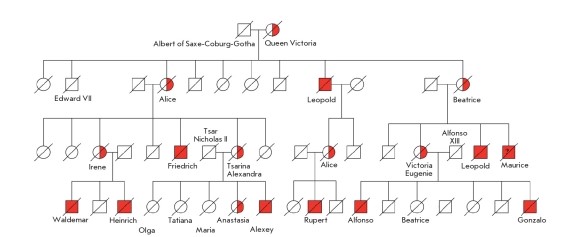
The really cool thing about a pedigree is that it is a tool that allows you to use an individual’s phenotype—the outward expression of a trait, to determine that individual’s genotype—what genes they possess.
What do I mean by that? Let me explain.
You already know that, for the most part, your observable traits are controlled by your genes. Often, more than one allele exists for a given gene. When more than one allele for a gene exists, one allele will be dominant over other alleles.
This is the case with eye color*.
What color eyes do you have? Brown? Blue? Green? Hazel? Your eye color is your phenotype—the outward expression of the genes you possess for eye color. The actual genes you possess is known as your genotype.
The allele for brown eyes (which we will designate B) is dominant over the allele for blue eyes (which we will designate b). Since we have two copies of every gene (one copy inherited from each parent during conception), we have two possible alleles for eye color.
A person with two copies of the brown eye allele (BB) will have brown eyes, while a person with two copies of the blue eye allele (bb) will have blue eyes. What color eyes will a person with one brown eye allele and one blue eye allele have (Bb)? They will have brown eyes. Why? Because having just a single copy of the dominant brown eye allele will mask expression from the recessive blue eye allele.

In this example, there are two different eye color phenotypes: blue and brown. But there are three possible genotypes (BB, Bb, bb).
While it is possible with commercial DNA testing kits to determine your genotype, you may be able to determine what genotype you and your family members have based on your phenotypes using a pedigree.
How to Construct a Family Pedigree
Choose a Trait
There are many traits you could choose to construct your pedigree, and a lot will depend on your particular family.
For instance, in my family, we have left-handed relatives on my side as well as my husband’s side. The fact that my husband, my younger son, and I are all right-handed while my older son is left-handed made this trait an interesting one to investigate.
You’ll want to choose a trait that is readily-observable (or easily testable, like the ability to taste PTC). Traits like eye color or the presence of a cleft chin can be ascertained from pictures, so choosing these traits would allow you to include family members who are far away (or even those who have passed away).
The more family members you are able to include, the more thorough your pedigree will be and the more information you will be able to glean from it.
Collect Your Information
After you’ve chosen what trait to study, your next step is to make a list of all of the family members you wish to include in your pedigree. In addition to yourself, you’ll want to include your parents and siblings. You can also include grandparents, aunts, uncles, and cousins. If you’re really ambitious, you can include great-grandparents, great aunts and uncles, second cousins, etc.
Next, determine which version of the trait you’ve chosen that each family member in your list has. For example, when I made my pedigree to trace how the gene for left-handedness was passed down through my family, I created a table like this.

Constructing Your Pedigree
While you are free to use whatever symbols you’d like, there are certain symbols that are universally used in pedigrees. The beauty of using these symbols is that anyone can look at your pedigree and understand it.
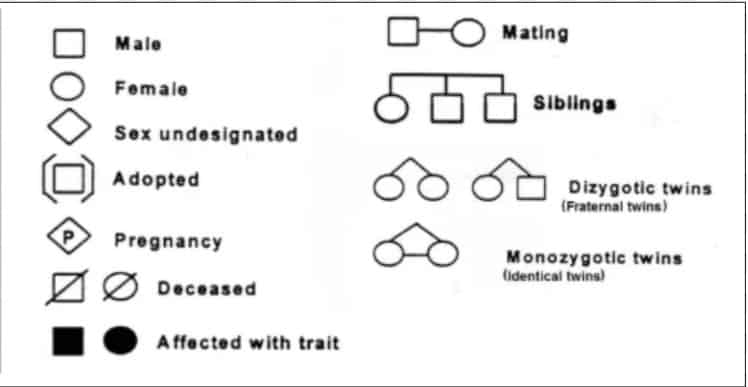
Males are generally represented as squares and females with circles. If a person displays the trait you have chosen, you will indicate that by coloring in the entire shape that represents them a solid color. If the person doesn’t have that trait, you will leave their shape empty.
A horizontal line is used to indicate that two people are married, while a vertical line connects a child to his or her parents.
Your next step is to begin drawing your pedigree on a blank piece of paper. You might want to start with the symbol representing yourself. If you are part of the youngest generation that you will include in your pedigree (i.e., you have no children, nieces, or nephews), you will probably want to place the symbol representing you towards the bottom center of your page.
If you have brothers or sisters, draw their symbols beside you. Once again, indicate whether or not they possess the trait you are tracking. Remember to indicate that you are siblings using lines as shown in the figure of pedigree symbols above.
Next, add symbols for your parents above you, linked with lines as indicated in the above figure, and indicating whether or not they possess the trait.
Continue the process for the rest of the family members you wish to include.
Here is the pedigree I constructed tracing left-handedness in my family.
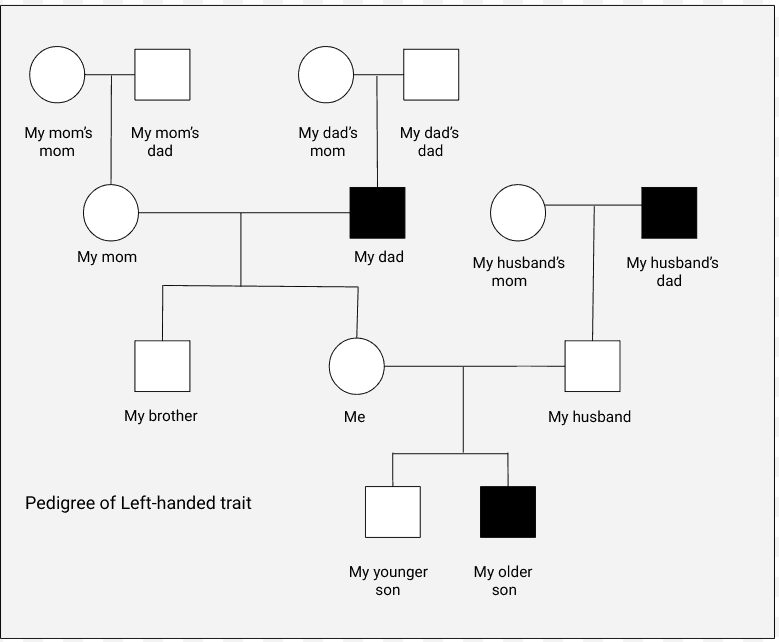
From my pedigree, you can see that not only is my older son left-handed, but so is my father and my husband’s father.
This pedigree is based on my family’s phenotype: their outward expression. But based on this pedigree, I can actually determine some facts about the genotype of some of my family members.
Using Your Pedigree to “See Inside” Your Genes
This initial pedigree, coupled with an understanding of genetics, allows me to make some assumptions.
The allele for left-handedness (which I will designate r) is recessive. Knowing that, I know that my older son must have two copies of the left-handedness allele (rr). Why? If he had even a single copy of the dominant allele for right-handedness, he would be right-handed. (By the same token, I also know that my father and my husband’s father both had two copies of the left-handedness allele.)
But how did my older son get two copies of the left-handed allele? After all, my husband and I are both right-handed.
My husband and I both must carry a copy of both alleles: the dominant allele for right-handedness (R) as well as the recessive allele for left-handedness. Even a single copy of the dominant allele for right-handedness is enough to mask expression of the recessive left-handed allele. But, while we are phenotypically right-handed, we were both able to pass down the gene for left-handedness to our son. With two copies of the left-handed gene—one from me and one from my husband—my older son is left-handed.
And where did my husband and I get our copies of the left-handed gene allele? Looking at the pedigree, we see that both of our fathers were left handed. Our fathers both passed on a copy of the recessive allele while our mothers both gave us a copy of the dominant allele for right-handedness. Both my husband and I must have the genotype Rr. Our phenotype—our outward expression of the trait—is that we are right handed. But we both carry a hidden copy of the recessive allele for left-handedness. We are considered “carriers” of the left-handed allele.
Using this logic, we can actually fill in some more information on my pedigree. I will indicate individuals who carry a hidden copy of the recessive left-handed allele by coloring in half of the shape that represents them.
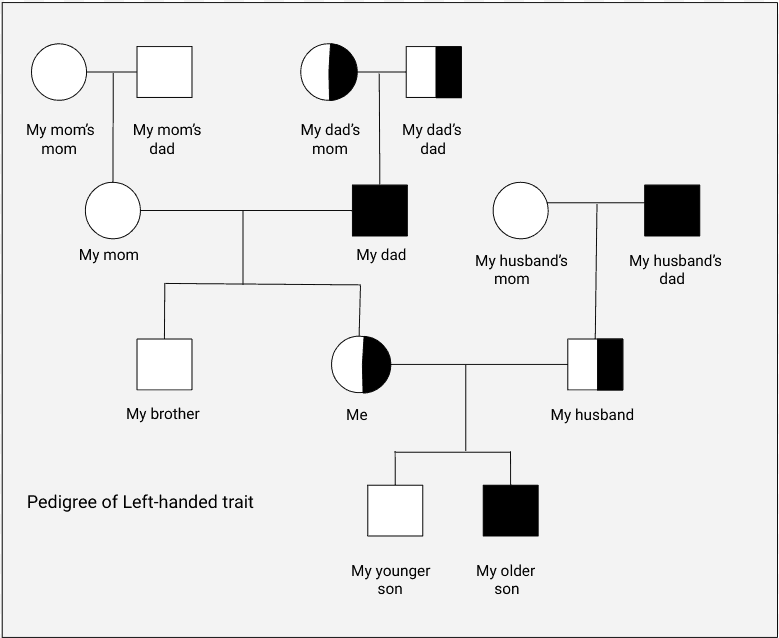
You should see that I also designated my father’s parents as carriers of the left-handed allele. Why? Because just like the case with my husband and me, the only way for two right-handed parents to produce a left-handed child is for them to carry a hidden copy of the left-handed allele (Rr).
It is possible that other members of my family have the carrier genotype too, but at this point, it’s impossible to know without more information.
For instance, my younger son is right-handed. There are two different genotypes that produce the right-handed phenotype: RR and Rr. He could have inherited two copies of the dominant R allele, or he could have a single copy of the right-handed allele and a hidden copy of the recessive left-handed allele. When he has children of his own (or even grandchildren), if any are left-handed, we will know that he is a carrier of the left-handed allele.
Genetic Traits You Could Use for a Family Pedigree
Depending on your family, there are many traits you could choose to construct your own pedigree. Here are just a few:
Earlobe attachment

Do your earlobes attach directly to the side of your head (attached) or do they hang free (unattached, or free)? Free earlobes is the dominant trait while attached earlobes are recessive.
Bent pinkies

Place your hands in front of you, palms up, with your two pinkies touching side to side. If the tips of your pinkies bend away from each other, you have bent pinkies, the dominant trait. If they don’t bend away from each other, you have straight pinkies, the recessive trait.
Hitchhiker’s thumb

A strangely-named but easily determined trait is known as the hitchhiker’s thumb. Observe your thumb as you give the “thumbs up” sign. If your thumb naturally bends back, you have hitchhiker’s thumb—a dominant trait. If your thumb stays straight, you have the recessive trait.
Hand clasp

Without thinking, clasp your hands in front of you. Now look at your clasped hands. Which thumb is on top, your right thumb or your left? Believe it or not, even this is determined by your genes! Clasping your hands with the left thumb on top is the dominant trait. However, if your right thumb was on top when you clasped your hands, you have the recessive trait.
Cleft chin

Another observable genetic trait is the presence or absence of a cleft chin which appears as a small indentation. The cleft chin allele is dominant while a smooth chin is recessive.
Morton’s toe

I don’t know who Morton was, but he’s got a strange trait named after him. If your “big” toe is shorter than your second toe, you have what is known as Morton’s toe, a dominant trait. If your second toe is shorter than your “big” toe, you have the recessive trait.
Widow’s peak

If your hairline comes to a point at the center of your forehead, you have what is known as a widow’s peak. The presence of a widow’s peak is a dominant trait, while a straight hairline is a recessive trait.
Sun sneezing

For some people, exposure to a bright light (like the sun) causes them to sneeze. Such individuals have been nicknamed “sun sneezers”. The sun sneezing trait is dominant.
The ability to taste PTC

PTC (Phenylthiocarbamide) is a harmless chemical with a peculiar property: depending on what genes a person has, PTC can taste vastly different.

To some, PTC tastes extremely bitter. To others, PTC has no discernible taste at all. Other individuals describe the taste of PTC as mildly bitter. The ability to taste PTC is a dominant trait, while the inability to taste PTC is recessive. Interestingly, people with a copy of both alleles have an intermediate phenotype: to them, PTC tastes only mildly bitter. Learn more about the genetics of PTC here.
Other Ideas
If color-blindness or dyslexia run in your family, you could create a pedigree to trace these traits. You could also construct a pedigree of blood types (A+, O-, etc.). Of course, using these traits will require a bit more research on your part since the phenotypes associated with these traits can’t be determined by outward examination.
Creating a family pedigree is a great way to make DNA expression and genetics come alive for students. It’s just one way to take the fear out of science, and to demonstrate that science isn’t just something in a textbook.
Science is everywhere.
If your students want a better understanding of DNA and how it governs observable traits like the ones we’ve just discussed, check out my self-paced, online classes.

In DNA: The Alphabet of Life, I cover the basics of DNA structure and function, and describe how genes are expressed through the processes of transcription and translation. I also explain how DNA mutations occur, and how they can lead to diseases such as sickle cell anemia, cystic fibrosis, Tay-Sachs disease, and cancer. Hands-on activities, videos, and instructions for experiments are included.

In Genetics and Heredity, we explore how DNA is manifested as observable traits. Students learn the principles of Mendelian Genetics and learn how to use Punnett Squares to predict the outcome of genetic crosses. I also explain the other forms of inheritance, including sex-linked traits, the inheritance of mitochondrial DNA, incomplete dominance, codominance, and polygenic inheritance. A wealth of activities are included to give students opportunities for hands-on learning. Many examples of real-world genetics are given, including the genetics of calico cats, human blood types, cystic fibrosis, color blindness, and more.
DNA expression, gene alleles, and heredity is something we study in my live, online biology class. If you’re looking for a fun, engaging science class for your high schooler that includes many opportunities for hands-on exploration, check out what I have to offer: High School Science Classes Taught by Dr. Kristin Moon
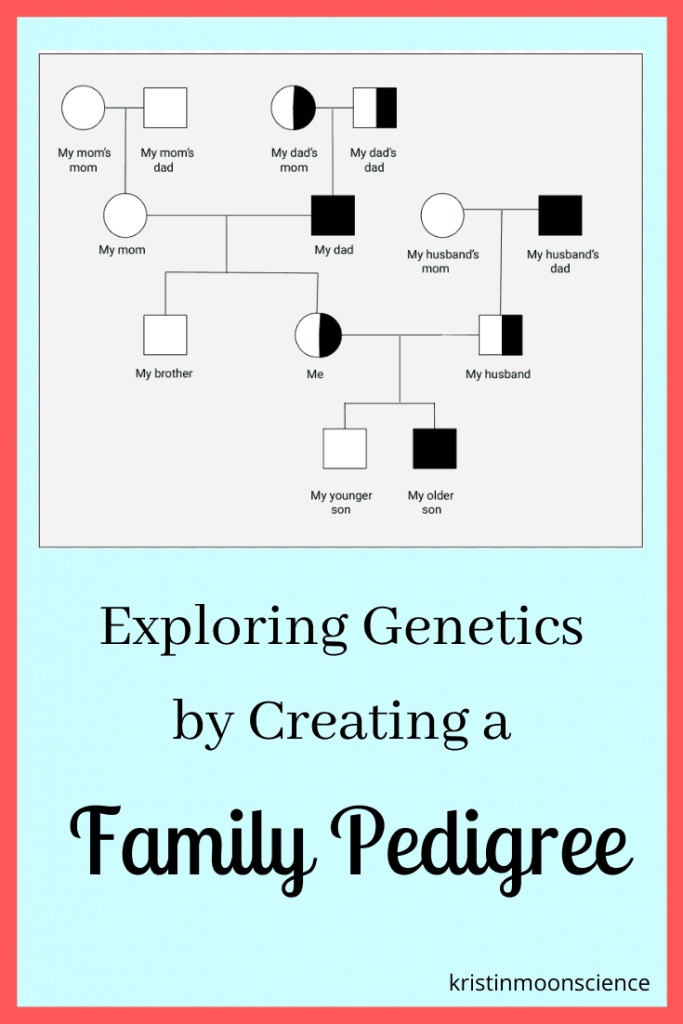
*This is an oversimplified explanation of how eye color is determined. The genetics of eye color are explored more thoroughly in Genetics and Heredity.
**As an affiliate for Amazon and Home Science Tools, I may earn a commission if you use my affiliate link to make a purchase. This doesn’t affect your price in any way, but helps me with the cost of maintaining my website so that I may continue to share resources to help you understand, teach, and love science.


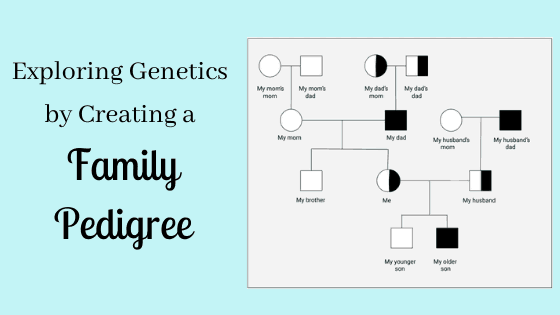



I absolutely love this idea! I am totally going to do this with my family. Thank you for such a great resource! I will keep you posted on how it goes.
I can’t wait to hear if you discover anything interesting! I love being able to “see inside” my genes!
I am adding this to my plans for next school year. I love how you have put everything I need to teach this right in one spot. Thank you it is such a life save.
I know you’ll enjoy doing this activity! If you make any neat discoveries, come back and let me know!